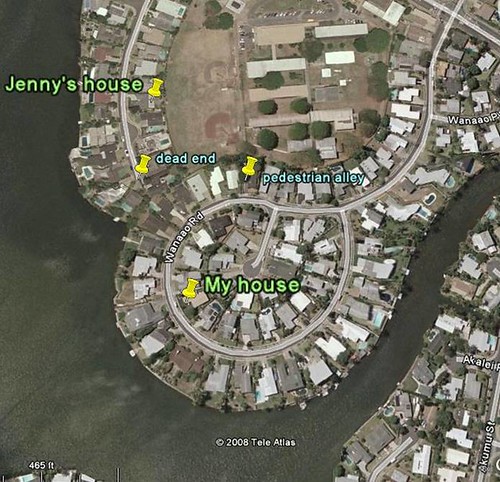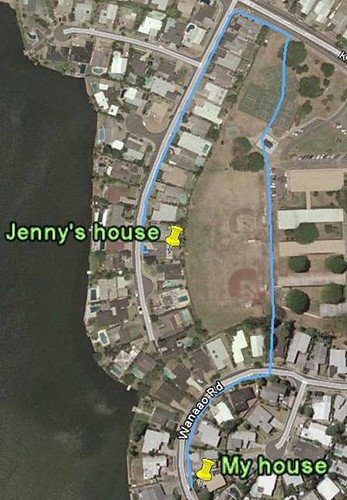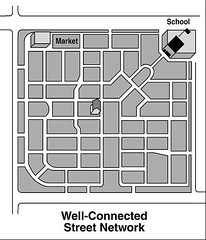Connected streets matter, or why Rachel still fears German Shepherds

Posted September 30, 2011 at 1:42PM
Emily Badger wrote an illuminating story in The Atlantic Cities about the myths surrounding cul-de-sac streets, explaining that they don't make your community as safe as you may think. She's right.
It is a subject I have discussed often, for example citing safety research and innovative street design rules from the Commonwealth of Virginia. Just as important, the most comprehensive analysis of transportation research undertaken to date concluded that the presence of connected streets - the antithesis of cul-de-sacs - is the number one indicator of how much walking takes place in a community, and the number two indicator of reduced driving.
But, of all the many discussions of the subject that I have read, including Badger's and my own, I have yet to see one as good as that written by my former colleague Rachel Sohmer some three years ago. Here it is, in Rachel's own words:
I grew up in a typical subdivision of detached single-family homes built in the 60s, where cul-de-sacs and long blocks ruled the day. On the plus side, our small houses and lot sizes made the neighborhood somewhat walkable, and someone even had the foresight to build a little pedestrian cut-through between my street and the back of my elementary school. But that might've been the only real concession to connectivity - pedestrian or otherwise - in the entire neighborhood. Case in point:
I lived in one loop of the subdivision, and my friend - let's call her Jenny - lived in another, just on the other side of the school kickball field:
As the crow flies, Jenny's house was practically next door, yet it was an absolute hassle to get to. But let's consider that Jenny had about 27 Barbie dolls, a copy of The Dark Crystal on VHS, and everything Hello Kitty ever made. I was highly motivated. However, between me and the spoils of Jenny's indulged childhood lay the proverbial fork in the (badly-planned) road. Which way to go?
The safe but loooong route (0.5 miles)...or the treacherous shortcut (0.2 miles)?
The shortcut was a substantial timesaver for a little kid with little legs, but it would mean scaling Jenny's back fence commando-style and then running the gauntlet of 'family dogs' (read: rabid German Shepherd psycho killer hellhounds) to get to the back door.
I don't know what they were feeding those dogs, but clearly it wasn't enough.* Maybe if I hadn't been totally terrified, I would have realized I was receiving an early lesson in the value of a well-connected street network. Don't get me wrong, as conventional suburbs go, mine could've been a lot worse. At least I had the option of walking to my friend's house in the first place, sparing my mom the even longer drive (0.75 miles).
But a well-connected street grid, with shorter blocks and frequent intersections, wouldn't have hurt. As Charlottesville, VA-based transportation planner Hannah Twaddell puts it,
"Regardless of their size, communities can realize three major benefits from better connectivity: shorter trips; a wider variety of travel choices; and more cost-effective public services and infrastructure.
"Creating more direct connections shortens travel time, which effectively brings people closer to their destinations. With more available connections, community residents can get to schools, shopping centers, and other spots that may have simply been off their radar before -- not because these places were too far away, but because they were too far out of the way."
She goes on to explain that good street connectivity also helps firefighters, paramedics, and police save precious minutes reaching the scene of an emergency, and as with other public services like garbage collection, operating costs are minimized by the reduced travel time and vehicle mileage.
And, of course, let's also consider the environmental and public health benefits of a well-connected street system. In addition to reducing gas consumption and vehicle emissions overall, good street connectivity helps decrease traffic congestion on arterial roads, making neighborhoods safer for pedestrians while reducing local hotspots of air pollution which can lead to respiratory illnesses. Also, connectivity is a key component of the smart growth mix - along with mixed land-uses and higher density - that encourages people to leave their cars at home and be more physically active.
If you're in the market for street connectivity design guidelines, check out the street network credit of the LEED for Neighborhood Development rating system. Perhaps if the developers who designed my neighborhood had access to planning resources like these, I might've been spared some mild childhood trauma. As it was, I usually took the shortcut to Jenny's house despite the dogs.
That's how much I hate following a bad street grid.
*The author is happy to report she eventually outgrew her fear of German Shepherds once she outweighed them. She is not as happy to report that she also outgrew The Dark Crystal.
Move your cursor over the images for credit information.






